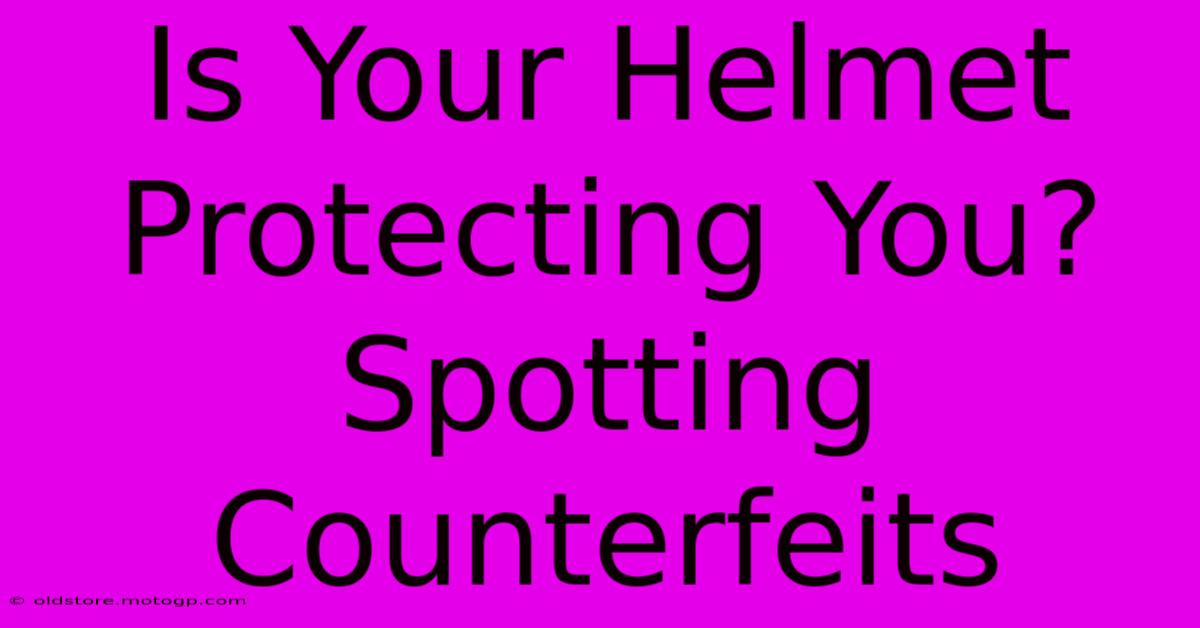Is Your Helmet Protecting You? Spotting Counterfeits

Table of Contents
Is Your Helmet Protecting You? Spotting Counterfeit Helmets
Your helmet is your first line of defense against serious injury. Whether you're a cyclist, motorcyclist, skateboarder, or rock climber, a helmet can mean the difference between a minor scrape and a life-altering accident. But what if the helmet you're trusting isn't what it seems? The rise of counterfeit helmets presents a serious threat, putting unsuspecting users at significant risk. This article will help you identify potential counterfeit helmets and ensure your headgear is genuinely protecting you.
The Dangers of Counterfeit Helmets
Counterfeit helmets are often made with substandard materials and lack crucial safety features. They may not meet any safety standards, meaning they're far less likely to protect your head in a crash. The consequences can be devastating:
- Increased risk of head trauma: A poorly constructed helmet might shatter on impact, offering little or no protection.
- Higher risk of concussions and other brain injuries: Even seemingly minor impacts can cause serious brain damage if your helmet fails to absorb the shock effectively.
- Neck injuries: A helmet that doesn't meet safety standards may not adequately support your head and neck in a fall, leading to injuries.
- Facial injuries: Counterfeits often lack adequate facial protection, increasing the risk of fractures and lacerations.
Don't gamble with your safety. A genuine, properly certified helmet is a worthwhile investment.
How to Spot a Counterfeit Helmet
Identifying a counterfeit can be tricky, but here are some key indicators:
1. Check the Packaging and Labeling:
- Poor quality printing and packaging: Look for blurry images, misspellings, or inconsistencies in the branding. Genuine helmets usually have high-quality packaging.
- Missing or incomplete certifications: Legitimate helmets will display certifications from relevant safety organizations (e.g., DOT, ECE, Snell). Always check for these certifications. A missing or vaguely worded certification is a red flag.
- Suspicious pricing: If a helmet is significantly cheaper than comparable models, it's likely a counterfeit. Be wary of "too good to be true" deals.
- Unusual barcodes or serial numbers: Verify the barcodes and serial numbers using online resources or by contacting the manufacturer.
2. Examine the Helmet Itself:
- Poorly finished construction: Look for rough edges, uneven stitching, or loose parts. Genuine helmets are typically well-constructed and have a smooth finish.
- Substandard materials: Feel the helmet's shell. Counterfeit helmets often use cheaper, less durable materials.
- Faulty straps and buckles: Check that the straps are securely attached and the buckles operate smoothly. Weak or flimsy straps are a major safety concern.
- Inconsistent branding: Compare the logos and markings on the helmet with those on the manufacturer's website. Discrepancies are a warning sign.
3. Where to Buy Your Helmet:
- Reputable Retailers: Purchase your helmet from authorized dealers or reputable online retailers with a proven track record. Avoid buying from unauthorized sellers or questionable websites.
- Check Reviews: Before purchasing, read online reviews from other customers. Negative reviews mentioning poor quality or safety concerns could indicate a counterfeit product.
Protecting Yourself: Beyond Spotting Counterfeits
While knowing how to spot a counterfeit is crucial, proactive steps can further enhance your safety:
- Research before you buy: Spend time researching different helmet brands and models to understand the features and safety standards they offer.
- Proper Fit is Crucial: A helmet that doesn't fit properly won't offer optimal protection. Get professionally fitted at a reputable retailer.
- Regular Inspection: Regularly inspect your helmet for any damage or wear and tear. Replace your helmet if it's been involved in a crash or shows signs of significant damage.
Your safety is paramount. Don't compromise on quality when it comes to your helmet. By being vigilant and informed, you can significantly reduce the risk of purchasing a counterfeit and ensure you're wearing a helmet that truly protects you.

Thank you for visiting our website wich cover about Is Your Helmet Protecting You? Spotting Counterfeits. We hope the information provided has been useful to you. Feel free to contact us if you have any questions or need further assistance. See you next time and dont miss to bookmark.
Featured Posts
-
Dont Be Fooled Recognizing Fake Helmet Features
Feb 19, 2025
-
F1 Weekend Austin Your Guide To Accessible Travel
Feb 19, 2025
-
Cota Parking Cota Parking Solutions
Feb 19, 2025
-
Austin Gp 2025 The Must See Event
Feb 19, 2025
-
Moto 2 Specs The Ultimate Guide For Racing Enthusiasts
Feb 19, 2025
